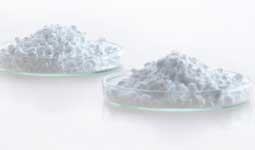For more than 70 years, the Ultrasil VN 3 active filler, developed by one of Evonik’s forerunners, has enabled the ongoing improvement of tyres and mechanical rubber goods. Claudine Mollenkopf, Senior Vice President Silica at Evonik, states, “This addition has been vital in the creation of super-wet-grip winter tires to boost safety, as well as ‘green tyres’ with lower rolling resistance to minimize fuel consumption and hence CO2 emissions.”
Since the 1940s, research had been conducted on silica as a substitute for carbon black as an active filler for tyres. The success story began in March 1951 in Wesseling (Germany), when chemist Dr Hans Verbeek (1908 – 1996) and his laboratory assistant, Peter Nauroth, created precipitated silica for the first time. This was the invention of “white carbon black”.
From 1953 on, the product was sold as Ultrasil VN 3, quickly becoming a substitute for filler carbon black and enabling the creation of coloured rubber compounds. The granulated version, Ultrasil VN 3 GR, is still the most widely used silica in the tyre and rubber industry worldwide, according to Evonik. The company claims to be the only chemical company in the world that manufactures both silica and silanes, which are still the key ingredients for sustainable “green tyres.
In the 1970s, Ultrasil was paired with silanes as a coupling agent. Silanes enable hydrophilic silica to be chemically coupled to the rubber polymer. Evonik’s Silica/Silane system is the benchmark for passenger car tire tread performance, particularly when it comes to improving the wet traction behaviour and reducing the rolling resistance. Using silica as a filler in place of carbon black can lower fuel consumption – and therefore also CO2 emissions – by up to 8%.
Ultrasil has since been used not only in the production of high-performance tyres, but also as a reinforcing filler for industrial rubber goods that require enhanced performance, such as timing or conveyor belts and seals, as well as for everyday items such as shoe soles and bicycle tyres.
“The amount of silica filler in the product will continue to rise. A new EU tyre label was introduced in May 2021, resulting in increased competition among tyre manufacturers as each one strives to get the highest ratings. Evonik’s senior vice president for Rubber Silica, Bernhard Schäfer, anticipates that countries outside the EU will follow suit soon.
Ultrasil is currently produced in ten locations across three continents, with its Wesseling facility remaining the world’s largest precipitated silica production facility.
The latest product development, Ultrasil 4000 GR, is the first low surface area silica (LSA silica) with high dispersibility and enables high filling levels, which allow the production of winter tyres that have even better traction in wet, muddy and snowy conditions, for example.
Meanwhile, tyres with a low rolling resistance will become even more important in the future of sustainable mobility, as they can help extend the range of electric cars, Roland Krafczyk, Vice President Global Applied Technology Tire & Rubber at Evonik said, adding that combining Ultrasil active filler and the Si 363 silane can reduce the rolling resistance by up to 35% and significantly improve wet grip, all while retaining the same good wear values.
Evonik’s silica business line is already researching further innovative silica/silane products for the next milestones in tyre development.
Evonik is inviting customers and partners to visit their anniversary website for more details –www.silica-specialist.com/en/our-products/ultrasil/rubber-silica-162630.html

